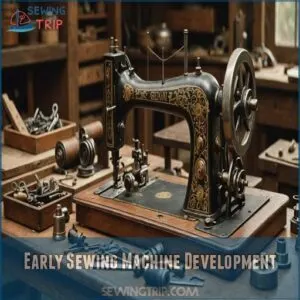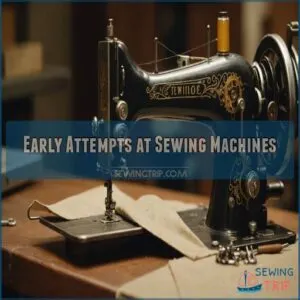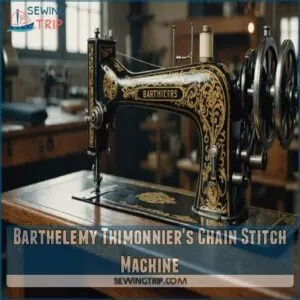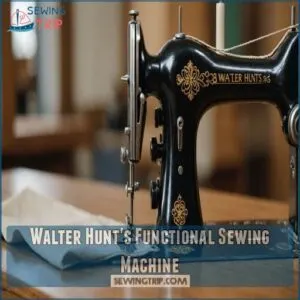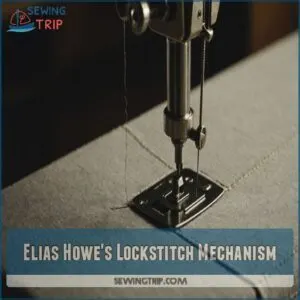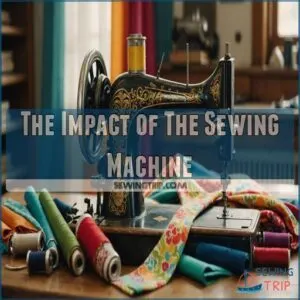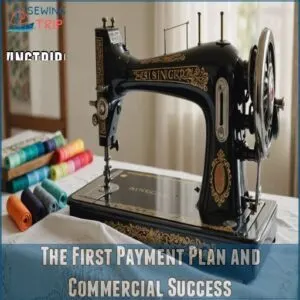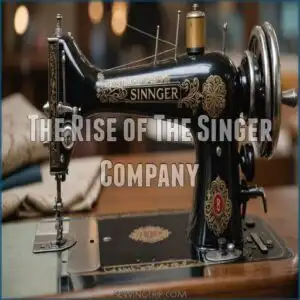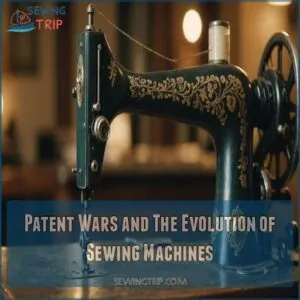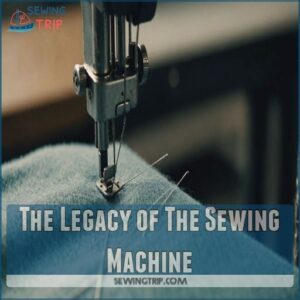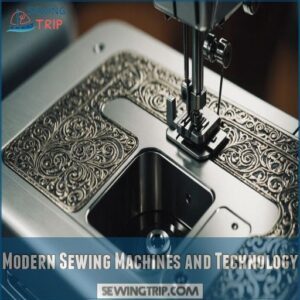This site is supported by our readers. We may earn a commission, at no cost to you, if you purchase through links.
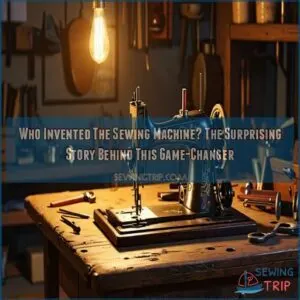
While many inventors took a stab at it, Elias Howe’s 1845 lockstitch mechanism stands out.
Imagine this: you’re sewing away by hand, dreaming of faster stitches.
Then here comes Howe, making speed dreams a reality.
But wait, he’s not the lone hero.
Folks like Walter Hunt and Barthelemy Thimonnier had their own nifty designs.
Each one added a stitch to the fabric of innovation.
So, what did they weave together next?
The story’s stitched with intrigue, and there’s more to unravel in the saga of sewing.
Table Of Contents
- Key Takeaways
- Early Sewing Machine Development
- Early Attempts at Sewing Machines
- Successful Sewing Machines and The Lockstitch
- The Impact of The Sewing Machine
- Isaac Singer and The Singer Sewing Machine
- Patent Wars and The Evolution of Sewing Machines
- Later Innovations and Advancements
- The Legacy of The Sewing Machine
- Modern Sewing Machines and Technology
- Frequently Asked Questions (FAQs)
- Conclusion
Key Takeaways
- Elias Howe’s 1845 lockstitch mechanism marked a significant breakthrough in sewing machine technology, leading to more efficient and durable sewing practices with its two-thread system.
- Barthelemy Thimonnier, Walter Hunt, and other inventors contributed to the evolution of the sewing machine, each adding valuable innovations that paved the way for future advancements.
- Isaac Singer did not invent the sewing machine but popularized it through effective marketing and improvements, making it more accessible and securing its commercial success.
- The sewing machine’s development involved multiple inventors and patent disputes, ultimately revolutionizing the fashion industry and impacting women’s roles and industrial production worldwide.
Early Sewing Machine Development
You might think the sewing machine popped up overnight, but it’s got a history longer than your grandma’s quilt.
From bone needles to the Industrial Revolution’s demand for speedy stitching, you’re about to unravel the tangled threads of early sewing machine development.
Hand Sewing and Early Needles
Your ancestors’ ingenuity would make you do a double-take.
Imagine this: 20,000 years ago, they’re crafting needles from bones and animal horns.
Talk about making do with what you’ve got!
These early MacGyvers weren’t stopping there – they turned animal sinew into thread.
It’s like the Stone Age version of "Project Runway."
Hand sewing was no walk in the park, but it got the job done.
Who knew our fashion-forward journey started with such humble beginnings?
Industrial Revolution and Early Patents
The Industrial Revolution stitched together a perfect storm for sewing machine innovation. You’d think inventing something to save your fingers would be a cinch, but it was anything but.
Early patents popped up like daisies, each inventor trying to thread the needle of success.
From side-to-side stitchers to winding handle contraptions, these early sewing machines were more comedy than convenience.
Talk about technological growing pains!
Charles Weisenthal’s Needle Design
As the Industrial Revolution chugged along, Charles Weisenthal stitched his name into history.
In 1755, this German inventor nabbed a British patent for a needle designed for a machine.
Talk about threading the needle of progress!
Later, innovators like sewing machine pioneers would build upon early designs, transforming the industry.
Weisenthal’s design was a real eye-opener, but here’s the kicker:
- No actual machine accompanied the needle
- The design was a double-pointed needle with an eye in the middle
- The design laid groundwork for future sewing machine needles
- It sparked curiosity about mechanized sewing possibilities
- Weisenthal’s patent predated most sewing machine attempts by decades
Thomas Saint’s Detailed Design
Surprisingly, it was an English cabinet maker who first dreamed up a detailed sewing machine design.
In 1790, Thomas Saint’s innovative blueprint laid the groundwork for future textile innovation.
His 18th-century sewing concept featured a clever needle moving side-to-side, powered by a winding handle.
Though Saint’s design never materialized, it sparked a revolution in machine mechanics.
Talk about threading the needle of invention!
Early Attempts at Sewing Machines
You might think inventing the sewing machine was a breeze, but early attempts were more like a comedy of errors.
From Balthasar Krems’ cap-sewing flop to John Adams Doge’s fabric-breaking fiasco, these ambitious inventors stitched together a patchwork of failures that would make even the most patient seamstress unravel.
Balthasar Krems’ Automatic Machine
Moving beyond early patents, we encounter Balthasar Krems’ 1810 invention – an automatic cap-sewing machine.
Talk about a head-scratcher!
This German inventor’s creation was a step in the direction of industrial sewing, but it hit a snag.
Despite its promise, the machine couldn’t cut the mustard and failed to revolutionize cap production.
Krems’ attempt, though unsuccessful, paved the way for future sewing machine inventors like Elias Howe.
Josef Madersperger’s Unsuccessful Designs
While Krems tinkered with cap-sewing machines, Josef Madersperger, an Austrian tailor, was stitching together his own dreams of mechanical sewing.
In 1814, he snagged a patent for his sewing machine design.
But don’t get too excited – this wasn’t exactly a rags-to-riches story.
Madersperger’s inventions were more like a comedy of errors:
- His first design mimicked hand-sewing motions, but ended up tangled in its own threads.
- The second attempt used a double-pointed needle, which proved about as useful as a chocolate teapot.
- His final design in 1839? Well, let’s just say it was more "Mad" than "Genius.
John Adams Doge and John Knowles’ First American Machine
The quest for a functional sewing machine continued across the pond.
In 1818, John Adams Doge and John Knowles took a stab at creating America’s first sewing machine.
Those interested in purchasing products related to their invention, such as the First American sewing machine, can find resources online.
Their invention was a real tease – it could only sew a few bits of fabric before throwing in the towel.
Talk about a stitch in time that didn’t save nine!
This early American innovation faced serious fabric challenges and serious difficulties.
Successful Sewing Machines and The Lockstitch
You’d think the sewing machine’s journey to success would be smooth sailing, but it was more like a tangled thread of trials and tribulations.
From Thimonnier’s chain-stitch contraption to Howe’s game-changing lockstitch, these inventors stitched together a revolution that would forever alter the fabric of our lives.
Barthelemy Thimonnier’s Chain Stitch Machine
Barthelemy Thimonnier, a French tailor, stitched his way into history in 1830 with his chain stitch machine.
Talk about a game-changer!
Here’s what you need to know:
- It used a hooked needle and one thread
- Created the world’s first machine-based clothing factory
- Produced military uniforms at lightning speed
- Sparked a riot among fearful tailors
Thimonnier’s invention was revolutionary, but it wasn’t smooth sailing.
His factory went up in flames, torched by workers worried about losing their jobs.
Talk about a hot topic!
Walter Hunt’s Functional Sewing Machine
Ever wonder about the sewing machine‘s unsung hero?
Enter Walter Hunt, who stitched together a functional marvel in 1834.
This needle-wielding wizard crafted a machine that could’ve revolutionized the industry, but he chose not to patent it.
Talk about a missed opportunity!
Let’s unravel Hunt’s decision and its ripple effect:
| Aspect | Hunt’s Decision | Impact |
|---|---|---|
| Invention | Created functional machine | Advanced sewing tech |
| Patent | Chose not to file | Opened door for others |
| Legacy | Overlooked innovator | Sparked future designs |
| Contribution | Lockstitch mechanism | Foundation for modern machines |
Elias Howe’s Lockstitch Mechanism
While Hunt’s design showed promise, Elias Howe stole the spotlight in 1845 with his groundbreaking lockstitch mechanism.
This clever contraption revolutionized sewing machine history:
- Used two threads for stronger seams
- Featured a needle with an eye at the point
- Incorporated a shuttle to create loops
- Produced a lockstitch on both sides of the fabric
You’d think Howe’s invention would be an instant hit, right?
Well, not quite. He struggled to market it, facing stiff competition from copycats who saw dollar signs in his design.
The Impact of The Sewing Machine
You’d be hard-pressed to find an invention that’s stitched itself into the fabric of society quite like the sewing machine.
From revolutionizing women’s fashion to turning the Wright brothers’ dreams of flight into reality, this humble contraption has sewn its way into history, one thread at a time.
Changes in Women’s Fashion
The lockstitch revolution didn’t stop at the factory floor—it stitched its way right into your closet.
With sewing machines humming, women’s fashion took a wild ride, thanks to pioneers like Barthélemy Thimonnier who developed the first working sewing machine.
Suddenly, intricate details and embellishments weren’t just for the elite.
You could whip up a trendy outfit faster than you could say "Isaac Merritt Singer."
Corsets? They started loosening their grip as clothing styles evolved.
Talk about a fashion liberation!
Industrial and Commercial Uses
Fashion wasn’t the only thing getting a makeover.
The sewing machine revolutionized industries faster than you can say "stitch in time."
Factories hummed with newfound efficiency as mass production took off.
Garment and textile manufacturing went into overdrive, churning out clothes quicker than ever.
Even the military got in on the action, with Russian soldiers sewing up a storm to outfit their army.
Talk about industrial strength!
Home Sewing and Craftsmanship
Gone are the days of endless hand-stitching!
Your trusty sewing machine has revolutionized home craftsmanship.
Now you can whip up DIY projects faster than you can say "bobbin."
From vintage machines to modern marvels, these time-savers let you explore fabric choices and sewing patterns with ease.
Remember when hand-stitching techniques were your only option?
Now, needlework’s a breeze, and your creativity can truly shine.
Who knew a little invention could thread together so much fun?
Isaac Singer and The Singer Sewing Machine
You’ve probably heard of Singer sewing machines, but did you know their creator, Isaac Singer, cared more about cash than creativity?
With a genius for business and a touch of scandal, Singer turned a simple invention into a money-making empire that changed the face of fashion and industry forever.
The First Payment Plan and Commercial Success
In spite of their hefty $125 price tag, Singer sewing machines became a household staple thanks to Isaac Merritt Singer’s genius marketing strategy.
You might say he stitched together the perfect plan for success:
- Introduced the first-ever payment plan
- Launched eye-catching early advertising campaigns
- Focused on affordability and accessibility
- Sparked the rise of mass production
Today, you can find a wide variety of Singer sewing machine models, from basic to advanced, available on this website, proving their enduring legacy.
Talk about threading the needle of commercial success! Singer’s approach revolutionized consumerism, making IM Singer Co. a true game-changer in the industry.
Patent Infringement and Royalties
You’d think inventing a revolutionary machine would be smooth sailing, right?
Not for Isaac Singer!
His sewing machine success hit a snag when Elias Howe sued for patent infringement.
Talk about a stitch-up!
The court battle ended with Singer forking over royalties faster than a needle through fabric.
Let’s break down this sewing saga:
| Player | Move | Outcome |
|---|---|---|
| Howe | Sues Singer | Wins lawsuit |
| Singer | Defends with Hunt’s design | Public domain, no dice |
| Both | Share patents | Become millionaires |
| You | Buy a sewing machine | Reap the benefits |
The Rise of The Singer Company
Ever wonder how a sewing machine company became a household name?
Enter Isaac Singer, the savvy businessman who turned Singer into America’s first multinational corporation.
He wasn’t just stitching together fabric; he was weaving a global empire.
With a revolutionary marketing strategy and a knack for innovation, Singer sewing machines sewed up the market.
Talk about threading the needle of success!
Patent Wars and The Evolution of Sewing Machines
You’d think inventing a sewing machine would be a straight stitch to success, but it was more like a tangled bobbin of lawsuits and patent wars.
From Howe suing Singer to the formation of the Sewing Machine Combination, the path to your trusty Singer was as dramatic as a fashion runway show gone wrong.
Elias Howe’s Lawsuit and Royalties
While Singer’s sewing machine took off, Elias Howe wasn’t about to let his invention slip through his fingers.
He sued Singer for patent infringement, sparking a legal battle that would change the industry.
The lawsuit was part of a larger series of patent wars that plagued the early sewing machine industry, including issues with Barthélemy Thimonnier and others who’d filed early sewing machine patents.
Here’s what went down:
- Howe’s lockstitch mechanism was at the dispute
- Singer tried to use Walter Hunt’s earlier design as a defense
- The court ruled in Howe’s favor, forcing Singer to pay up
- Royalties turned Howe into a millionaire, raking in $200,000 annually
The Sewing Machine Combination and Patents
The sewing machine industry’s patent wars reached a boiling point in 1856.
Four major players, including Singer, decided to play nice and formed the Sewing Machine Combination.
This clever move pooled their patents, forcing other manufacturers to pay up for licenses.
It was like a sewing machine mafia, controlling the market and squashing competition.
The legal battles cooled down, but innovation heated up as companies focused on improving their machines instead of bickering.
The Expiration of Patents and New Innovations
You’d think patent expiration would stifle innovation, but it actually freed a wave of creativity in the sewing machine world.
As legal shackles fell away, inventors went wild with new designs, and people started exploring the market for products related to Sewing machine evolution, like those found on websites such as this Sewing machine evolution store.
The competitive landscape heated up, sparking technological breakthroughs left and right. It’s like the sewing machine industry got a shot of espresso!
From Thomas Saint‘s early concept to John Fisher’s game-changing improvements, this innovation wave stitched together a tapestry of progress that’d make your head spin.
Later Innovations and Advancements
You’d think sewing machines couldn’t get any better, but inventors had other plans.
From zigzag stitches to computerized wonders, these needle-wielding marvels evolved faster than you can say "thread the bobbin.
The Vibrating Shuttle Bobbin and Zigzag Stitch
As patent wars settled, sewing machine innovation kicked into high gear.
Allen Wilson’s vibrating shuttle bobbin in 1850 revolutionized sewing speed and efficiency.
Then, in 1873, Helen Blanchard stitched up history with the first zigzag stitch patent.
These advancements transformed sewing from a chore to a creative outlet.
Imagine the impact:
- Seamstresses whizzing through projects like greased lightning
- Fabric edges no longer fraying faster than you can say "bobbin"
- Decorative stitches turning plain Jane garments into runway-ready showstoppers
Portable and Computerized Sewing Machines
Sewing machines went from bulky behemoths to pocket-sized powerhouses.
In 1945, Bernina introduced the first portable zigzag machine, letting you stitch on the go.
The later development of computerized sewing machines with advanced features has made a significant impact on the industry, offering users precision control, stitch memory, and sensor technology.
Fast forward to 1990, and Janome’s Memory Craft 8000 brought embroidery to your fingertips.
These tech marvels have made sewing a breeze, with computerized precision that’d make your great-grandma’s head spin.
Who knew threading a needle could be so high-tech?
The Rise of Japanese Manufacturers
Japanese sewing machine makers threaded their way into the global market with impressive skill.
Brother started the trend in 1908, mass-producing machines like hot cakes.
Janome followed in the 1920s, giving Singer a serious case of pins and needles.
These Asian innovators didn’t just copy; they stitched up new ideas.
With razor-sharp focus on quality and cutting-edge tech, they’ve sewn up a hefty portion of the market, leaving old-timers in tatters.
The Legacy of The Sewing Machine
You’d never guess how a simple sewing machine changed the world, from revolutionizing women’s fashion to helping build the first airplane.
It’s not just your grandma’s favorite hobby tool – this game-changing invention stitched together the fabric of modern society, leaving a legacy that’s anything but seamless.
Impact on Women’s Lives and Employment
The game-changing sewing machine revolutionized women’s roles faster than you can say "stitch in time."
It opened doors to new opportunities but also brought challenges.
Here’s how it shook things up:
- Factory work: Women flocked to garment factories, facing long hours and tough conditions.
- Home economics: Sewing at home became a way to earn extra income.
- Wage gaps: Despite increased employment, women often earned less than men.
Talk about a double-edged needle!
Changes in The Fashion Industry
While women found new opportunities, the fashion world was turning upside down.
Mass-produced clothing hit the scene like a tsunami, washing away the old ways.
Suddenly, ready-to-wear became all the rage, and haute couture had to up its game.
You’d think garment workers would be out of a job, but nope!
They just switched gears, churning out trendy pieces faster than you can say "patent lawsuit.
The Sewing Machine’s Iconic Status
From fashion revolution to polar exploration, the humble sewing machine has stitched its way into history.
You’ve probably seen one in your grandma’s attic, but did you know it helped the Wright brothers take flight?
This game-changer didn’t just transform clothing manufacturing; it became a symbol of American ingenuity.
Even Mahatma Gandhi, typically anti-machine, tipped his hat to Singer’s creation.
Talk about a cultural thread that just keeps on spinning!
Modern Sewing Machines and Technology
So, you think you know sewing machines?
Think again!
From computerized embroidery to mind-boggling design advancements, modern sewing machines are light years beyond those clunky early models—and they’re only getting more sophisticated.
Computerized Machines and Embroidery
After impacting fashion and industry, today’s sewing marvels pack a punch with computerized machines.
Imagine creating embroidery designs with digital patterns, guided by embroidery software—it’s machine quilting 2.0!
Worried about mastering embroidery digitizing?
Don’t sweat it. These machines are like having a crafty buddy who knows the sewing machine history timeline better than your grandma.
Advances in Sewing Machine Design
With computerized machines showcasing embroidery capabilities, sewing hasn’t just kept pace; it’s leading modernization.
Imagine sewing machines now with electric motors, transforming effort into efficiency.
Foot pedals aren’t relics—they’re your secret productivity hack.
Adding flair, the zigzag stitch elevates ordinary fabrics.
Through clever sewing machine design and timeless sewing machine invention, stitching isn’t work; it’s creative genius set free.
The Future of Sewing Machines
You’ve marveled at modern sewing machine designs, but what’s next?
Picture a world where AI integration and smart fabrics influence your creative process.
Sustainable sewing and 3D printing turn DIY fashion into a breeze, making clothing manufacturing as personal as a homemade pie.
So don’t just stitch—orchestrate!
And remember, your next needle might just be a patent law suit away.
Frequently Asked Questions (FAQs)
Who invented the lockstitch sewing machine?
Elias Howe invented the lockstitch sewing machine in 1845, revolutionizing sewing with a two-thread system.
Imagine the impact—suddenly, sewing wasn’t just a labor of love, but a faster, more efficient craft.
This invention ushered in the modern era of clothing.
How did the sewing machine change the world?
Imagine life without sewing machines—wardrobe woes galore!
They revolutionized fashion with intricate designs, sparked industrial growth, and even aided explorers like Byrd in polar escapades.
A stitch in time truly paved the way for modern machinery marvels.
Who invented the Singer sewing machine?
Isaac Singer didn’t invent the sewing machine, but he sure electrified the industry.
He improved the design by adding a foot pedal and better needle mechanism, making it more accessible.
Talk about sewing up success in style!
What is a sewing machine used for?
A sewing machine’s your ticket to crafting clothes, repairing torn seams, and creating decorative items.
It stitches fabric together with speed and precision, transforming tedious needlework into a breeze.
You’ll feel like a sewing wizard!
Who invented the sewing machine?
You probably expect a straightforward answer, but the sewing machine’s invention isn’t so simple.
Credit goes to many, like Barthelemy Thimonnier in 1830 and Elias Howe in 1845, each contributing key steps in its development.
When did sewing machines come out?
Sewing machines burst onto the scene like game-changers in the 19th century, transforming textile production.
Sewing machines revolutionized the way clothing and other textile products were made.
In 1830, French tailor Barthelemy Thimonnier patented the first practical model.
Elias Howe’s lockstitch design in 1845 marked a significant advancement.
Who invented the original sewing machine?
There’s no single inventor! Many contributed. Elias Howe’s lockstitch was key, but others like Singer improved and popularized the machine, making it a household name. It’s a collaborative story!
Who invented the sewing machine in 1793?
Thomas Saint, an English cabinet maker, holds credit for designing the first sewing machine in 1790, not
He aimed to streamline leather and canvas stitching.
Though never built, his design paved the way for future innovations.
Is Singer the first sewing machine?
No, Singer wasn’t the first out of the gate with sewing machines.
Although Isaac Singer made them famous with the first commercially successful model, the first patent went to Thomas Saint in
Singer’s version just sewed its legacy.
Who invented the sewing machine in 1842?
You’ll find no record of someone inventing the sewing machine in
The famous Elias Howe patented his version in 1846, but 1842 remains a mystery year in sewing machine lore.
An exciting, unsolved puzzle!
What materials were used in early needles?
Back in the day, needles weren’t your typical metal variety; they were crafted from humble beginnings, like bones or animal horns.
Imagine stitching with those!
To complete the ensemble, threads were made from animal sinew.
When was the first zigzag stitch invented?
The zigzag stitch first made its mark in 1873, thanks to Helen Augusta Blanchard in Maine.
Imagine the relief of crafters finally achieving sturdy seams and decorative flair, all without the frustration of hand-sewing intricacies.
Who invented the vibrating shuttle bobbin?
Allen Wilson invented the vibrating shuttle bobbin in the 1850s.
His innovation revolutionized sewing machines by improving stitch quality and speed.
It stitched its way into the heart of sewing tech, making life easier for many seamstresses.
Which country first mass-produced sewing machines?
Japan was the first country to mass-produce sewing machines. Think of it: millions of machines, stitching their way into history! Brother Sewing Machine Company led the charge, starting in
How did sewing machines impact the fashion industry?
Sewing machines were the glam squad of the fashion world, enabling exquisite designs faster than ever.
They sparked a trend wave, transforming wardrobes with intricate stitches and embellishments, while tailoring fashion’s future faster than a gossip spreads.
Conclusion
So, who invented the sewing machine?
Picture a tapestry of ideas where Elias Howe took the spotlight with his lockstitch, while Thimonnier and Hunt added their own threads.
Each played a part, weaving bold innovations that spun the sewing machine into a game-changer.
From revolutionizing fashion to turbocharging industry, the sewing machine’s tale is stitched with brilliance and drama.
Next time you sew, remember, it’s not just fabric that’s woven—it’s history.

